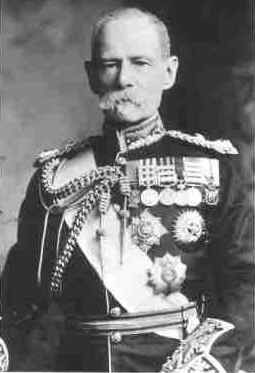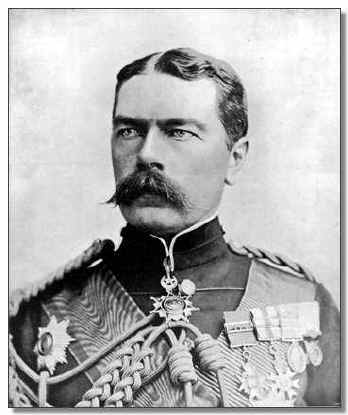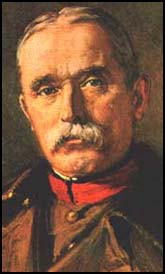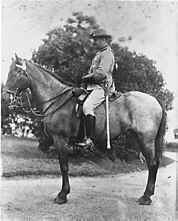 |
| Category: The Leaders |

|
|
|
|
|
| Allied
Leaders of the 2nd Boer War |
 |
Frederick
Sleigh Roberts ("Bobs")
Field Marshall Lord Roberts of Kandahar, V.C., K.G., K.P., G.C.B., O.M.,
G.C.S.I., G.C.I.E.
After the disastrous actions in the
Boer war in South Africa in December 1899 at Magersfontein, Stormberg
and Colenso, where his only son was killed, Lord Roberts was sent out as
Commander-in-Chief.
He arrived at Cape Town on the 10th of
January 1900, and after organizing his force, advanced with sound
strategy on Bloemfontein, the capital of the Orange Tree State, and soon
changed the aspect of affairs. |
|
The sieges of
Kimberley and Ladysmith were raised, and the Boer General Cronje, flying
towards the capital, was overtaken at Paardeberg and, after a fine
defence, compelled to surrender, with 5000 men on the anniversary of
Majuba Day, the 27th of February 1900.
Roberts entered
Bloemfontein on the 13th of March, and after six weeks' preparation,
advanced on Pretoria, the capital of the Transvaal. Mafeking was
relieved on the 17th of May, and Pretoria occupied on the 5th of June.
The two Boer states were annexed, and the war gradually assuming a guerrilla
character, Roberts handed over the command to Lord Kitchener and
returned to England to fill the office of Commander-in-Chief of the Army
in succession to Lord Wolseley
He arrived in the Solent on the 2nd of
January 1901, and the same day, had an audience of Queen Victoria, who
handed him the insignia of the Order of the Garter. The next day he was
received at Paddington by the Prince and Princess of Wales and drove in
procession to Buckingham Palace, where he was entertained as the guest
of the Queen. He again had an audience of the green at Osborne on the
14th of January on his elevation to an Earldom, the last audience given
by Her Majesty before her death, which took place eight days later. When
the German emperor came to London for the Queen's funeral, he decorated
Lord Roberts with the Order of the Black Eagle.
Earl Roberts received the thanks of
both Houses of Parliament and a grant of £100,000 for his services in
South Africa. In 1905 he resigned his post on the Committee of National
Defence, and devoted himself to attempting to rouse his countrymen to
the necessity of cultivating rifle shooting and of adopting systematic
general military training and service. As an author he is known by his
Rise of Wellington (1895), and his Forty-One Years in India (1897), an
autobiography which has passed through numerous editions.
Above text from the Encyclopaedia
Britannica, 11th Edition, 1910-1911.
 |
Later in
World War 1 as
Earl Roberts
(called "Bobs")
he became Colonel In Chief of the Forces from Overseas
(those "damned colonials").
He was much loved by British troops and
respected by the Australians.
Because of his Victoria
Cross he was recognized by
the Diggers as a 'fighting soldier'.
How his pretty uniform went down with the Diggers is not recorded. |
|
 |
LORD
KITCHENER OF KHARTOUM.
Commissioned in the Royal Engineers,
in 1886 Kitchener was appointed governor of the British Red Sea
territories and subsequently became commander in chief of the Egyptian
army in 1892.
In 1898 he crushed the separatist
Sudanese forces of al-Mahdi in the Battle of Omdurman and then occupied
the nearby city of Khartoum, where his success saw him ennobled in 1898.
In 1900 he became Commander in Chief
of the Boer War, where he fought the guerrillas by burning farms and
herding women and children into disease-ridden concentration camps.
These ruthless measures helped weaken
resistance and bring British victory. |
| On
returning to England in 1902 he was created Viscount Kitchener and was
appointed commander in chief in India. In September 1911 he became the
proconsul of Egypt, ruling there and in the Sudan until August 1914.
When war broke out, Kitchener was on leave in England and reluctantly
accepted an appointment to the cabinet as Secretary of State for War.
Flying in the face of popular opinion, he warned that the conflict would
be decided by Britain's last 1,000,000 men. He rapidly enlisted and
trained vast numbers of volunteers for a succession of entirely new
'Kitchener armies', or "The New Army" as it was dubbed. By the
end of 1915 he was convinced of the need for military conscription, but
never publicly advocated it, deferring to Prime Minister Asquith's
belief that it was not yet politically practicable.
In his recruitment of soldiers,
planning of strategy and mobilisation of industry, Kitchener was
handicapped by bureaucracy and his own dislike for teamwork and
delegation. His cabinet associates did not share the public's worship of
Kitchener and gradually relieved him of his responsibilities for
industrial mobilisation and then strategy. He was killed in 1916 when
HMS Hampshire was sunk by a German mine while taking him to Russia. |
 |
John
French
the son of Captain William French
and Margaret Eccles, was born in Ripple, Kent in 1852. He joined the
navy in 1866, but transferred to the army in 1874. He served with the
19th Hussars in the Sudan (1884-85) and was a cavalry
commander in South Africa during the Boer War (1899-1901). Appointed
Chief of Staff of the British Army in 1911, French took command of the
British Expeditionary Force sent to Europe in August 1914. Ironically,
his sister, Charlotte Despard, was one of Britain's leading anti-war
campaigners.
After Mons, French became very pessimistic about the outcome of the war
and Lord Kitchener, Secretary for War, had to apply pressure in order to
persuade him to take part in the Marne offensive. French resigned in
December, 1915 and Sir Douglas Haig replaced him as leader of the BEF.
French, as commander of the British home forces, was responsible for
dealing with the Easter Rising in 1916. |
| Rewarded with the post of Lord
Lieutenant of Ireland (1918-1921), French was granted £50,000 by the
British government when he retired. Sir John French died in 1925. |
 |
Lieutenant-Colonel
Percy Ricardo Chief of Staff, Queensland Mounted Infantry,
Pretoria 31st July, 1900.
Percy came from a county family with a
military heritage. He not only led the First Contingent of the
Queensland Mounted Infantry but also became one of Australia's more
notable Military figures of his time.
No evidence has been found to date
that he ever actually attended any Military College in England prior to
his immigration to Australia (between 1874 and 1884 where he is first
located in 'Sydney'), although there is a 'Helmet' plume in the
Regimental Museum, Brisbane, that purports to be from his service in the
'Canadian |
| Military
Forces' (the 'Royal Horse Artillery') and study at the 'Military
College', Kingston, Ontario (Canada) [although the article in 1900
printed by the Alcazar Press - "Queensland, 1900, A Narrative of
her past" states otherwise]
Also see Colonel Percy Ralph Ricadro, C.B. "The Father of QMI"
It is also noted in the 'Australian
Dictionary of Biography - Vol. 11, (p.360)' that he served in the
'Canadian Artillery'. He is also alleged to have attended the Canadian
Military College in 1871 but this appears incorrect at the CMC was not
in existence until 1876.
Percy was, if anything, a colourful
character. He was notable for a variety of reasons including - his being
fined £1 for 'Obscene Language' following the 'Shearers Strike' in 1891
(he declined to defend against it) where he commanded the First
Detachment of Mounted Infantry sent to Clermont after which his
restraint was commended by William Hamilton (but the labour movement
resented his apparent snobbish attitude, his exhortation to his volunteers
'to protect their hearths and homes' from the strikers) and again in
1894, and the 'Libel Suit' against the 'Brisbane Newspaper Corporation'
in 1901 (in which fellow officer Major Harry Chauvel - Later General
'Sir Harry' Chauvel testified).
Very little is known of his
early years apart from 'Family Stories' which include his schooling at
Cheltenham, and his attendance at the 'Royal Agricultural College' at
Cirencester in England, where he is said to have studied 'Mechanical
Engineering, Agriculture and Veterinary Surgery'. Unfortunately the Royal
Agricultural College (RAC) does not have records of students for this
period, however the subjects listed were available at that time. He is
purported to have travelled extensively following his graduation from the
RAC in 1874, visiting Europe, North Africa, the Indian Sub-Continent and
the USA before arriving in Australia. If he came to Australia via the USA
and Canada, there is the possibility that he may have seen service there,
but there is no evidence that he was in any army prior to 1884.
He leased 'Waterview'
Station, on the Herbert River and from 1879, managed and partly owned 'Franklyn
Vale' (with Henry Mort), near Laidley, until defeated by drought.
A business associate of
'Sir Arthur Palmer' and 'Sir Thomas McIlwraith' , he was secretary of the
Queensland Turf Club but, from all accounts he was accused of
'tactlessness' and resigned in 1885, to become secretary of the Queensland
Ice & Freezing Co.
In 1884, Percy, who by this
time had married Annabella Lyall, moved his family to 'Blackall St.
Brisbane and took up the position of Manager of the Brisbane Ice Works to
which he eventually became Managing Director. It was at this time, while
managing the Ice Works that he took up his future trade of soldiering.
His Military experience in
Queensland, Australia, started in 1885 and continued up to his death in
1907, and is well documented, with all his appointments and promotions
recorded in the Queensland Government Gazette.
The Strike Breakers
The Shearer's Strike of
1891 was the first opportunity for most Queensland soldiers to see any
sort of extended service. The 'Moreton Mounted Infantry' was mobilised for
service on the 21st February 1891 in aid of the civil powers to prevent
Strikers from disrupting the peace. Within 24 hours Percy and his men had
sailed from Brisbane for Rockhampton. They entrained for Clermont, where
local graziers had agreed to provide horses for the troops. While in the
area they were used as escorts to Strike Breakers and guards for
woolsheds, trains, public buildings and Strike Breakers camps. In late
April the centre of the strike had moved with the season and the troops
set off overland from Clermont to Charleville.
Percy Ricardo avoided the
long wet ride by travelling by train to Rockhampton, ship to Brisbane and
train to Charleville. It was while he was in Brisbane that he was charged
with the use of offensive language and rather than defend the charge he
pleaded guilty and paid a fine of £5.00
The crisis finally resolved
when the strikers ran out of money and had to return to work, the
Queensland Defence force however, had learnt a substantial deal about
operating for extended periods in remote areas, horse care and soldiering.
Discipline had shown it's
worth with no loss of life caused by military action and the failure of
systems and equipment enabled the force to make many changes of a positive
nature.
In December 1891, Major
Percy Ricardo was transferred from the 'Moreton Mounted Infantry' to the
'Queensland Defence Department Head Quarters' as 'Staff Officer for
Mounted Infantry' (SOMI), a position that would result in his overseeing
in 1897 the reorganisation of the small local units into the State Wide
'Queensland Mounted Infantry'.
Percy Ricardo returned to
England twice during his career. From 23 May 1885 to 18 May 1886 he was
granted leave from Moreton Mounted Infantry to return to England. In 1897
he was Commander in charge of the Queen Victoria 'Diamond Jubilee'
contingent from the Queensland Defence Department (both these events are
recorded in official documents). It is believed that during his leave of
absence he took the opportunity to work with mounted troops in England to
further his education.
Percy Ralph Ricardo died on
4 June 1907, in Melbourne after he suffered a fractured skull when he was
thrown by a horse onto a tree stump whilst attending the 'Melbourne
Hounds' near Lyndhurst in Victoria. His funeral was of an Anglican Service
and his favourite Charger (Carnage) led the cortege to his gravesite.
Reports of his death were in the 'Melbourne Age' - June 1907, and the
'Queenslander' - 8 June 1907 (p.16) Newspapers. These two obituaries (the
Age and The Argus) in June 1907 are interesting in contrast, one simple
and the other very prosaic, if not very accurate (Death certificate
Registration No. 5561/1907). The report of his death in the 'Brisbane
Courier' (June 5, 1907) was a simple four lines after the heading 'FATAL
RESULT OF AN ACCIDENT'.
|
|